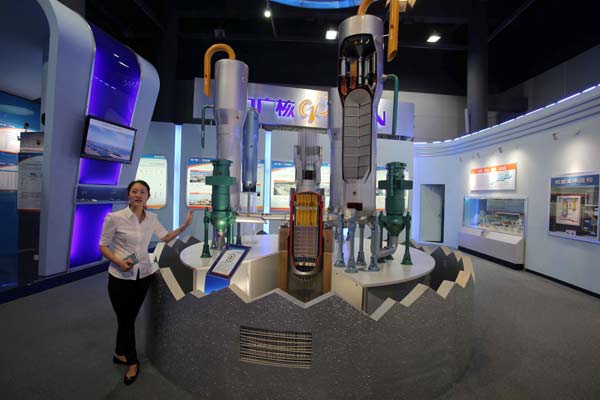

The exhibition hall of the Daya Bay nuclear power plant. Wang Jing / China Daily
New plan sets four levels of response and steps for dealing with accidents
China has pledged to strengthen its capability to handle any possible nuclear emergencies, according to a plan approved by the State Council on Tuesday.
The national nuclear emergency plan, based on a previous edition issued in 2005, stipulates the structure and responsibilities of China's nuclear emergency response system.
It sets four levels of emergency response for possible incidents or accidents in civil nuclear stations and lists directions for dealing with accidents that may happen during the transportation of spent nuclear fuel or aerospace vehicles equipped with nuclear devices.
By the end of 2012, China, which began to build its first nuclear power station in 1985, had 17 reactors in operation and 28 more under construction. Nuclear power contributes 1.7 percent of China's electricity consumption, according to the China Atomic Energy Authority, which is in charge of coordinating interministerial efforts on nuclear emergency responses.
Compared with the 2005 edition, the new plan is "more practical and comprehensive in terms of technical preparation, personnel training, logistics and information exchange", said Xu Ping, deputy director of the nuclear emergency response and safety department at the authority.
He said the plan also sets clearer tasks and coordination mechanisms for government departments and companies when a crisis takes place, noting it regulates that accurate information must be published publicly in a timely and transparent manner once an incident or accident occurs.
Since China established its nuclear industry in the 1950s, the government has attached great importance to nuclear safety and emergency response, said Ma Xingrui, vice-minister of industry and information technology and head of the China Atomic Energy Authority.
In 1991, the State Council established a national committee to cope with any nuclear emergencies. Though a host of ministries and departments have been disbanded or merged during governmental structural reforms over the past two decades, the committee remains due to its importance.
"Since last year, President Xi Jinping, Premier Li Keqiang and other top leaders have requested related authorities and companies to enhance their readiness for any nuclear contingency so the safety of the nation's nuclear plants can be guaranteed," Ma said.
Thus far, 16 provinces, autonomous regions and municipalities have established nuclear emergency response committees.
The country's nuclear emergency response system has successfully addressed several incidents over the past five years, Ma said. He said Chinese professionals proved their ability through their handling of the negative impacts on China's nuclear power industry brought about by the devastating earthquake in Sichuan province in 2008 and the meltdown at the Fukushima Daiichi Nuclear Power Plant in Japan in 2011.
To improve China's capability of handling nuclear emergencies, Ma's administration has allocated nearly 1 billion yuan ($163 million) to found four national technical support centers and six emergency response and rescue units. He added the administration is also working on the constitution of a national nuclear emergency response and rescue team.
Copyright ©1999-2018
Chinanews.com. All rights reserved.
Reproduction in whole or in part without permission is prohibited.